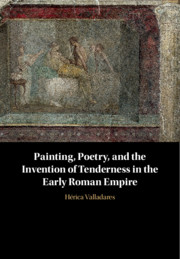Book contents
- Painting, Poetry, and the Invention of Tenderness in the Early Roman Empire
- Painting, Poetry, and the Invention of Tenderness in the Early Roman Empire
- Copyright page
- Dedication
- Contents
- List of Plates
- List of Figures
- List of Tables
- Acknowledgments
- Introduction On Roman Tenderness
- One The Tenderness of Lovers
- Two The Tenderness of Monsters
- Three The Tender Interior
- Epilogue Tenderness Transformed
- Notes
- Bibliography
- Index
Three - The Tender Interior
Published online by Cambridge University Press: 26 November 2020
- Painting, Poetry, and the Invention of Tenderness in the Early Roman Empire
- Painting, Poetry, and the Invention of Tenderness in the Early Roman Empire
- Copyright page
- Dedication
- Contents
- List of Plates
- List of Figures
- List of Tables
- Acknowledgments
- Introduction On Roman Tenderness
- One The Tenderness of Lovers
- Two The Tenderness of Monsters
- Three The Tender Interior
- Epilogue Tenderness Transformed
- Notes
- Bibliography
- Index
Summary
This chapter continues the theme of dissemination by investigating two Pompeian wall paintings of Medea – one from the House of Jason and the other from the House of the Dioscuri – that show her contemplating the murder of her children. Building on the previous chapter, the argument now turns to the literal and figurative domestication of this ultimate monstrosity. By analyzing these paintings in conjunction with Ovid’s Heroides 12 (Medea’s epistle to Jason), we see how these images of Medea in a domestic setting invite viewers to (re)create the heroine’s own inner struggle – a process that would have rendered her sympathetic in the eyes of ancient spectators attuned to the figure of an abandoned elegiac lover. Whereas the lovers discussed in the previous chapters primarily evince tenderness through togetherness, Medea in her isolation becomes sympathetic through Jason’s conspicuous absence, which drives her to her horrific deed. That absence, of course, is also the necessary conceit of Ovid’s epistolary elegiac fictions. Far from the haughty, vengeful goddess of Euripidean tragedy, Medea in the poetry and painting of first-century Rome displays tender characteristics that resonate with early Imperial notions of marriage and domesticity.
Keywords
- Type
- Chapter
- Information
- Publisher: Cambridge University PressPrint publication year: 2020

